








Intro
Our guide speaks English fluently. He will beat all the digital pages and books you have turned about Anuradhapura. We look for some exceptional knowledge about the site, experience in the fields, education backgrounds and service orientation in them.
Main sites covered - Jaya Sri Maha Bodhi, Isurumuniya & Ranmasu Uyana, Maha Viharaya & Ruwanweliseya, Jethawanaramaya (site & museum), Citadel and Abhayagiriya (site & museum) and more.
What you will listen to - History of Buddhism, ancient water management skills, ancient architecture, cultural stratification (prehistory, protohistory and history), inscriptions and evidence found from excavations, ancient hospitals and health care (spa treatment) system & more.
If you go alone, read about each separate sites before you go there to enjoy them.
Anuradhapura UNESCO city complex is famous for its relatively-well-preserved ancient ruins. This is the third place which was adopted as the capital of Rajarata Kingdom, from 4th century BC onward to up until 11th century AD. The kingdom of Tambapanni and Upatissa Nuwara were the first and second capitals of our island respectively. During Anuradhapura's hey days it remained as one of the most stable, prosperous city centers in entire South Asia. The city faced away as results of South Indian invaders and religious conflicts.
King Pandukabhaya, 437 BC to 367 BC, made Anuradhapura the capital city of this Island. He formally planned the city with gates, quarters for traders and Basawakkulama reservoir and etc. It was when his grand son was ruling, Devanampiya Tissa, 307 BC to 267 BC, the Buddhism was first introduced to Sri Lanka. It was 236 years after the passing away of Lord Buddha.
According to 'Thirumagal Inscription', the year 993 marked the demise of Anuradhapura Kingdom. Grand city of Anuradhapura was ruined by the Raja Raja Chola I's invasion. After that Raja Raja Chola himself had to shift the capital to Polonnaruwa. It was in 1070, Vijayabahu I unified the Island again.
What now you go there to see is the leftover from this majestic grand city. Observe the meticulous details of Kuttam Pokuna to understand the attention to details of this era. It is an impressive site! Read about each separate sites before you go there if you really want to enjoy them.
You could clearly see the driving route to this destination from BI Airport on Google Map. Locations of local bus station, train stations, ATM machines and other tourist interests are also on the map. To have a clear view click " ![]() " and then un-click "
" and then un-click " ![]() " irrelevant layers. We constantly update our site with all those interesting facts.
" irrelevant layers. We constantly update our site with all those interesting facts.
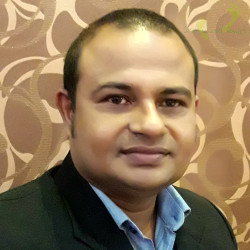
Name - Thusitha Wagalawatta (Dr. rer. nat).
Education - PHD from Freie Universität Berlin.
Work experience - Research Assistant at Department of Archaeology, University lecturer and a writer.
Field experience - Thusitha has worked over 25 excavation sites in management capacities since 2001.
Recent reviews
-
 Colombo Port City - Golf Drive Range Rated 5 out of 5by Chandula Wanasinghe
Colombo Port City - Golf Drive Range Rated 5 out of 5by Chandula Wanasinghe -
 Reserve a Tuk Tuks - Unlimited Kms Rated 5 out of 5by Thomas Ask
Reserve a Tuk Tuks - Unlimited Kms Rated 5 out of 5by Thomas Ask -
 British Sergeant - Scuba Dive Site - Pasikuda Rated 5 out of 5by Olivenzo
British Sergeant - Scuba Dive Site - Pasikuda Rated 5 out of 5by Olivenzo -
 Nil Diya Pokuna Caving - For Foreign Visitors Rated 5 out of 5by Anuj gunasena
Nil Diya Pokuna Caving - For Foreign Visitors Rated 5 out of 5by Anuj gunasena -
 Skydiving - Sri Lanka Rated 5 out of 5by Veno
Skydiving - Sri Lanka Rated 5 out of 5by Veno -
 Reserve Your Vehicle with a Driver Rated 5 out of 5by Elvina
Reserve Your Vehicle with a Driver Rated 5 out of 5by Elvina -
 Snorkeling With Whales Rated 5 out of 5by Elvina
Snorkeling With Whales Rated 5 out of 5by Elvina
About this city tour
Best season : All year around
Available : Daily
Best time to start : Early mornings and afternoons
Arranging time needed : 1 day
Hottest month :
Pick up point : 5 KMs from Anuradhapura city area
Whole touring hrs : 4
Total Kms driven : 25
Transportation : Select from above (Our guide uses your transportation)
Restrictions : No flash photography of ancient paintings. Cover your knees and shoulders before enter any temple. Do not leave plastics behind / Please do not feed wild animals.
Price includes : Transportation / Entrance tickets to Anuradhapura UNESCO site & Isurumuniya Temple / Professional guide / All Gov tax.
Child price : Aged 6 - 12 is considered a child / Aged 0 - 6 is free of charge.
Feedback us : Our drivers and service providers are advised not to promote any other activities or nugging you for shopping. Please leave your feedback on Google.
You may bring : Sandals or shoes which easily removable / Pair of socks if you do not like to walk barefoot / Clothes which cover your shoulders and knees / Hat and sun glass / Sun creams / Camera
Reserve your bicycle : Click here
We love holiday planning!
MORE DETAILS
Anuradhapura (අනුරාධපුරය) ancient city complex - (BC 377 - AD 1017)
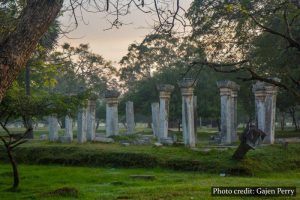 One of King Vijaya's, so-called founding father of this Island, commanders named Anuradha had made this city his home in 5 century BC, according to Mahavamsa Chronicle.
One of King Vijaya's, so-called founding father of this Island, commanders named Anuradha had made this city his home in 5 century BC, according to Mahavamsa Chronicle.
However, it is in 377 BC the King Pandukabhaya, 437 – 367, made the Anuradhapura capital of this Island.
Next significant period is of the King Devanampiya Tissa, 306 BC – 266 BC, in Anuradhapura. It is while he was in reign, Mahinda Thera brought Buddhism to Sri Lanka in 236 BC. Same year, the Theravada Buddhism was established. First ever Theravada Buddhist monastery, Mahaviharaya, and Sri Maha Bodhi Tree, sacred Bo tree, was planted.
Ever since, the religion and politics go hand in hand in this nation too.
According to 'Thiruvalangadu Copper-Plate Inscriptions' the year 993 marked the demise of Anuradhapura Kingdom. Grand city of Anuradhapura was ruined by the Raja Raja Chola I's invasion. In 991, Mahinda’s army mutinied by Raja Raja Chola I with the help of mercenaries from Kerala. Mahinda sought refuge in the southern region of Ruhuna. King Mahinda V was the last King in Anuradhapura with Sinhala lineage. The capital of Rajarata was moved to Polonnaruwa by Chola I.
What now you go there to see is the leftover from this-was majestic grand city. It is an impressive site!
Observe Kuttam Pokuna to understand the tedious attention given to architectural details in this period.
Read about each separate site before you go there if you want to enjoy them.
We keep updating our site often with all those interesting facts.
Opening time
7.30 AM - 6 PM
Time at the site
Approximately - half a day
Basawakkulama (බසවක්කුලම) or Abhaya Wewa (අභය වැව)
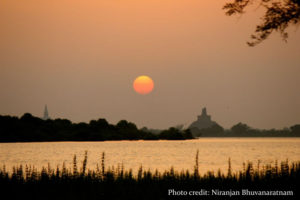 Basawakkulama reservoir was built by King Pandukabhaya, 437 BC to 367 BC.
Basawakkulama reservoir was built by King Pandukabhaya, 437 BC to 367 BC.
Jaya Sri Maha Bodhi (ජය ශ්රී මහා බොධිය)

Jaya Sri Maha Bodhi was planted by King Devanampiya Tissa in 288 BC.
This Sacred Bo tree holds the record to be the first ever recorded tree planted in human history.
The right (south) wing branch of the historical Sri Maha Bodhi at Buddha Gaya in India under which Lord Buddha attained Enlightenment was brought to Sri Lanka by Sangamitha Thera, the daughter of Emperor Asoka. She is also the founder of an order of Buddhist nuns in Sri Lanka.
Today visitors from all over the world come to visit Jaya Sri Maha Bodhi Tree and offer their due respect regardless of their religious affiliations.
Maha Viharaya Temple
Maha Viharaya Temple was established by King Devanam Piya Tissa.
The Maha Viharaya temple of Anuradhapura is the first ever Buddhist monastery of Sri Lanka. It was built after the arrival of arahant Mahendra Maha Thero in 236 BC.
It is 2,247 years old by now. With this Maha Viharaya Theravada Buddhism was incepted in the country.
King Devanampiya offered his royal park Maha Meghavana Udyanaya to this themple. The ancient boundary wall built where the King marked the boundary with his royal tusker and the silver plough, can be seen even today.
Tissa Wewa - tank
Tissa Wewa was built by King Devanam Piya Tissa. This Wewa has an area of approximately 400 acres. Only Panda Wewa and Abhaya Wewa are considered to be older than Tissa Wewa.
The embankment of Tissa Wewa is two miles long and 25 feet high. The width of the top of the reservoir was found to be 12 feet and the slope of the embankment is three horizontals to one vertical.
Base of this embankment is 160 feet - Compare this to a 300 ft long soccer field. Henry Parker, a British engineer, writes that this embankment was made so solidly that it would last forever!
You could enjoy this tank from your vehicle or could walk alone the embankment.
Coming back to the hotel after cycling along the tank, seen the sun sets, is a nice way to conclude the day too!
Isurumuniya Temple
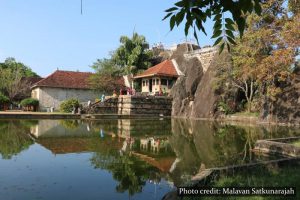 King Devanam Piya Tissa built this Temple to house 500 Buddhist monks.
King Devanam Piya Tissa built this Temple to house 500 Buddhist monks.
At his time, when Buddhism was introduced to Sri Lanka, 30,000 young men were ordained to this newly found religion. Among them was this high born 500 children.
This temple is famous for three stone carved figures. It believes one of those carvings, the couple in love, represents Saliya and Asokamala. Prince Saliya is a son of King Dutugemunu. Asokamala is a low caste maiden. Prince Saliya had to given up the throne to marry Asokamala. The second carving is of the Royal Family and the last one is above the pond outside, the carving elephants.
Thuparamaya
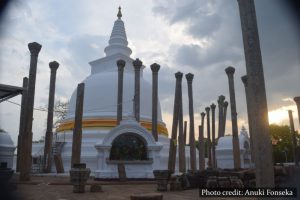
Thuparamaya was built by King Devanam Piya Tissa.
Thuparamaya is considered to be the first ever stupa built in Sri Lanka following the introduction of Buddhism.
At a request of Mahinda Thera King Devanampiyatissa built this Thuparamaya.
Vessagiri

Vessagiri Monastery was built by King Devanam Piyatissa.
It is situated near south of Issarasamanaka Vihara.
The Ruwanwelisaya
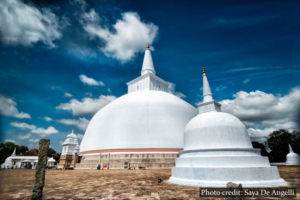 It was commenced by King Dutugemunu, 161 BC to 137 BC, who defeated Chola King, Elara.
It was commenced by King Dutugemunu, 161 BC to 137 BC, who defeated Chola King, Elara.
King Dutugemunu, however, did not live to see Ruwanweliseya completed. He passed away just before plastering work was finished.
The Mahavamsa, historical conical, states that dying king is taken by palanquin to the vicinity of the incomplete stupa. Then he listens to a monk, Theraputtbhya, his old colleague. It says, after some discussion of the mortality of men, with his old friend/monk the aged monarch passed away in 137 BC.
However, a folk tale carries that dying King was told that Ruwanweliseya was completed in order to keep him happy. Then King Dutugemunu asked to be shown the finished building. His brother, Saddhatissa, had the entire building draped in white cloth to present the illusion of whitewash, and due to his failing eyesight Dutugemunu did not spot the difference and he convinced that the building was finished.
King Saddhatissa completed the remaining work at the Great Stūpa.
This stupa belongs to Solosmasthana (the 16 places of veneration) and the Atamasthana (the 8 places of veneration) in the ancient sacred city of Anuradhapura.
The Kaunghmudaw Pagoda in Sagaing in Myanmar is modeled after this stupa.
Loha Prasada / Lovamahapaya

Lovamahapaya was built by King Dutugemunu, 164 BC – 140 BC.
Loha Pasada had nine stories and had 1,000 rooms. Read Mahavamsa
This place was built for as a Buddhist monastery. It included a refectory, communal kitchen, and the uposathagara, disciplinary place for monks. There was also a Simamalakaya too, a place for Sangha to assemble on Full Moon days to recite the dahma.
One side of the building was 120m in length. There are 40 rows, each row consisting of 40 stone pillars and a total of 1,600 stone pillars were used for the building. It is believed that it took 6 years for the construction of the building and the plan was brought from the heavens. The building was destroyed by fire during the reign of King Saddhatissa, 137-119 BC, and it was built to seven storeys. King Sirinaga II, 240-242 AC, restored this building again to five storeys. King Jettatissa, 266-276 AC, once again raised the size of the building to seven storeys.
Then King Mahasena, 277-303, completely demolished this building and gave the material to the Abayaghiri Viharaya due to a conflict with the monks in the Mahavihara. His son Sirimeghavanna rebuild this mansion again and was destroyed again by the Pandayns from South India who invaded the city in the 9th century and was rebuild again in the same century by king Sena II.
Again the Colas from India invaded the city in 10th century and plundered the city of its all valuables which finally saw the fall of the Anuradhapura as the capital of Sri Lanka after over 1400 years.
The great king Parakramabhu I who reigned from Polonnaruwa (1153-1186 AC) raised again the 1600 pillars and partly restored it. This is what you see today.
As the roof was covered with tiles made of bronze, this was known as the Brazen Palace.
Mirisawetiya (මිරිසවැටිය)

King Dutugamunu (161 BC to 137 BC) built the Mirisaveti Stupa after defeating King Elara.
After placing the Buddha relics in the sceptre, King Dutugamunu had gone to Tissa Wewa for a bath leaving the sceptre.
After the bath King returned to the place where the sceptre was placed, and it is said that it could not be moved. The stupa was built in the place where the sceptre stood. It is also said that he remembered that he partook a chilly curry without offering it to the sangha. In order to punish himself he built the Mirisavetiya Dagaba. The extent of this land is about 50 acres (20 ha). Although the king Kasyapa I and Kasyapa V renovated this, from time to time it was dilapidated.
Abhayagiri Monastery
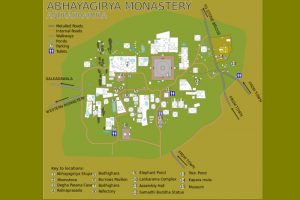
Abhayagiri Monastery was built by King Vattagamini or Walagambahu, 104 BC – 77 BC.
This monastery stands majestically at a 235 hectare land. This monastery is a collection of large buildings, assembly halls, resident halls, kitchens, ponds to bath for bikkus (monks) and ponds to bath elephants and so on. Click on the image to see its full scale.
Abhayagiri Dagoba, Kuttam Pokuna, Samadhi Buddha Statue, Lankarama Dagaba and Refectory of Abayagiri Monastery are only few of the points we have access to today. Observe them in Goolge Map.
The long story short goes like this, King Walagambahu's army, in 104 BC, was defeated by an Damila army, invading South Indian army, and the King made the decision to flee. After seen the King was fleeing, the chief ascetic of the Tittharama, named Giri yelled at the King 'Maha Kala Sihala is fleeing' (Black Sinhala King is fleeing). Hearing the words of Giri, King said to himself that one day he would build a vihara at the location of Tittharama.
After 15 years of planing and coordination he fought the South Indian invaders to become the King of whole Sri Lanka for the second term, 89 BC – 77 BC. Therefore, the King Walagamba is a legendary leader in Sinhala history.
As he made the promised to himself he demolished the Tittharama and built the Abhayagiri Monastery in that place.
But notice this monastery was established as a Mahayana Monastery, favoring King's good friend, bhikku Mahatissa.
Sri Lankan Government official only accommodates Theravada Buddhism.
Abhayagiri Dagoba
 Abhayagiri Dagoba was built by King Walagambahu, 104 BC – 77 BC.
Abhayagiri Dagoba was built by King Walagambahu, 104 BC – 77 BC.
It is 115 m in height and considered on of the largest Stupa in the world. It is among the largest structure in the world with Kufu’s Pyramid, Kafre’s pyramid and red pyramid.
The long story short goes like this, King Walagambahu's army, in 104 BC, was defeated by an Damila army, invading South Indian army, and the King made the decision to flee. After seen the King was fleeing, the chief ascetic of the Tittharama, named Giri yelled at the King 'Maha Kala Sihala is fleeing' (Black Sinhala King is fleeing). Hearing the words of Giri, King said to himself that one day he would build a vihara at the location of Tittharama.
After 15 years of planing and coordination he fought the South Indian invaders to become the King of whole Sri Lanka for the second term, 89 BC – 77 BC. Therefore, the King Walagamba is a legendary leader in Sinhala history.
As he made the promised to himself he demolished the Tittharama and built the Abhayagiri Monastery in that place.
But notice this monastery was established as a Mahayana Monastery, favoring King's good friend, bhikku Mahatissa.
Sri Lankan Government official only accommodates Theravada Buddhism.
Nuwara Wewa (Lake)

Nuwara Wewa was attributed to King Walagamba.
This 100 BC reservoir has a capacity of 1,500 million cubic ft and a surface area of 3,180 acres.
Nuwara wewa has an embankment of three miles. Height of the embankment varies from 37 ft to 12 ft depending upon the elevation of the ground. Top of the embankment is 12 to 16 ft wide. The embankment is sloped at 3 horizontals to 1 vertical. Two sluices (one at low level and another at high level) have been provided for water discharge.
Bricks used in sluices of Nuwara Wewa are 9.85 inches wide and 3.15 inches thick. The size of bricks used at Abhayagiri Dagaba is identical with these bricks.
Eth pokuna
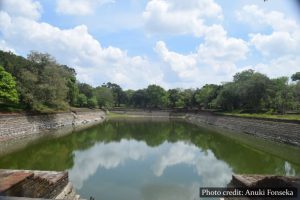
Eth pokuna was built by King Walagambahu, 104 BC – 77 BC. It is part of the Abayagiri Monastery.
Kuttam Pouna
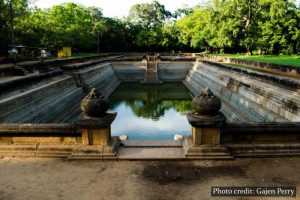
Kuttam (twin) Pokuna was built by King Walagambahu, 104 BC – 77 BC. It is part of the Abayagiri Monastery.
These are the best specimen of bathing pools in ancient Sri Lanka, if not in the entire planet.
Craftsmanship of these ponds point to significant achievements in the field of hydrological engineering, architecture and artistic creations in ancient history.
The larger pool of two is 132 ft by 51 ft. The smaller pool is 91 ft by 51 ft. The depths of the two pools is 14 ft and 18 ft respectively.
Jethawanaramaya
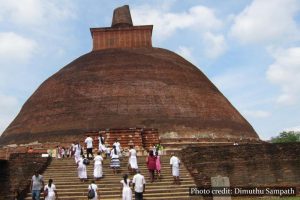
Construction of Jethawanaramaya was initiated by King Mahasena, 277 – 304 AD. His son Maghavanna I completed the construction of the stupa.
The conflict existed between Buddhist sects brought this stupa into being. A brief note into this long story as follows;
At the time of King Mahasena's coronation a monk Samghamitta who came from India to conduct coronation ceremonies put a word to the king that `the dwellers in the Mahavihara do not teach the true vinaya (disciplines), and we are the only ones who teach the true vinaya'. So, the king established a royal penalty, `whosoever gives food to a Bhikkhu dwelling in the Mahavihara is liable to a fine of a hundred pieces of money.’ Read Mahavamsa. The bhikkhus in the Mahavihara had to abandon the Mahavihara. The unwise thera persuaded this unwise king to destroy the Mahavihara. And this Samghamitta set on people to do so. Samghamitta and his associates destroyed the building complex attached to Mahaviharaya including splendid Lohapasada, which was seven stories high at the time.
Increasing resentment against this king resulted one of king's ministers, Meghavannábhaya, to rebel against the king. But the night before the battle Meghavannábhaya wanted to share splendid meat and drink he possessed with the King. So he approached the king with them. The King who enjoyed this feast asked Meghavannábhaya why he rebels against him. Meghavannábhaya explains that Mahavihara is to be re-established. King agrees.
One of the king’s wives, who is also the daughter of a Meghavannábhaya, assassinates Samghamitta.
King Mahasena initiated the construction of Jetavanaramaya. The height of the stupa is 122 m, making it the tallest stupa in the ancient world. It is still the largest the structure as such with a base-area of 233,000 m2. Approximately 93.3 million baked bricks were used in its construction.
Mihintale Monastery

Mihintale rock (Cetiya-pabbata) Monastery and cave complex were initially constructed by King Devanam Piya Tissa.
It is located about fifteen KMs east of Anuradhapura.
This is where King Davanam Piya Tissa was approached by the Mahinda Thera.
Buddhist viharas complex was gradually built by coming kings and princes. Read Mahavamsa. A hospital, a Refectory and Naga and Singha Pokunɑ are part of the monastery complex.
You could ascend to the peak of Mihintale by way of a large number of steps.
Opening time
7 am - 8 pm
Time at the site
Approximately - 2 hrs
Guard Stones
This common feature is seen before at the entrances of all most all ancient religious and kingly buildings. What is it?
The guardstone is a stone slab that is curved at the top. It is sometimes called Mura Gala. Usually it is the starting point for Koravak Gala (the dragon's figure) or railings.
It has the figure of coconut flowers on a pot (Pun Kalasa) which is considered the sole symbol of prosperity from ancient times. The Buddhist culture claims that the full pot is the mark of fertility, wealth and prosperity. Therefore, the artist has duly infused the concept of prosperity into the guardstone and thereby ascribed prosperity to the particular place. Some tells it symbolises solemnity and depth of the place the visitor is entering.
Dwarfs
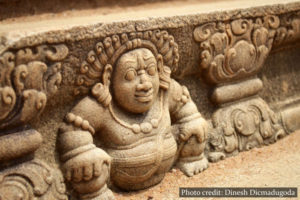
Some gaurd stones depict dwarfs, in fact two dwarfs.
They were the bodyguards of Kuvera, the god of wealth. They were called Sanka and Padma. These dwarfs were believed to be safeguarding the wealth and the place of Kuvera. They were the sole protectors of everything entrusted to them.
So, with those dwarfs at the forefront of entrances the owners expect those characters to be indicative.
Moonstone / Sandakadapahana

Though described as the moonstone due to its shape and design, it is really a semi-circular stone doorstep set up at the entrance to a stupa, vihara and palaces.
During the Anuradhapura period it was found at the entrance to king Mahasena’s palace and during the Polonnaruwa period it was found at the entrance to king Parakramabahu’s council chambers also.
Dr. Senerat Paranavitana describes the general characteristics in the design ornamenting a moonstone. Paranavitana's version is as follow;
The Elephant - Represents birth / The Lion - Represents disease / The Bull - Represents decay / The Horse - Represents death / The Geese - Represents good and bad / The Lotus - Represents purity - Paranavitana does not say this. But the lotus is regarded as a sacred flower by the Buddhists. For example, soon after the Buddha (then Prince Siddartha) was born he walked seven steps. For each step one lotus sprang into bloom at the feet of Prince Siddartha.
“A conventional half-lotus in the centre enclosed by concentric bands which, proceeding outwards, are decorated respectively with a procession of geese, an intricate foliage design, a procession of the four beasts and an outermost band of stylized flames. The various elements of the design are skillfully integrated into a very effective whole. The motifs which constitute the design are symbolic”, Dr. Paranavitana. Furthermore, Dr. Paranavitana considered it depicts a passage to nirvana through the cycles in sansara (ever lasting life and death circle to enlightenment).
Dr. D. Devendra, however, considered it to be an ancient decorative doormat.
Question - Great questions remain however as to why Paranavitana interprets the symbol of lion as the representation of disease when it represents Sinhala nation. Read dissenting points, 1.
Lively corner
Anula Devi (a consort) poisons 6 kings and bed with 32 palace-guards
Anula was one of the King Coranaga's consorts. King Coranaga is King Walagambahu's son. Very unlike his father Coranaga had destroyed eighteen Buddhist temples in his 12 years reign because he had not found refuge at those places during the time hiding.
Our story states as Anula poisoned Coranaga. And by the time Anula was enamoured with first gate watchmen, whose name was Siva.
Who became the King after Coranaga, King Thissa, was also had a short reign because Anula used the same technic to kill king Tissa.
Because of her love for this gate-watchmen she made him the king. He reigned only a year and two months in the city. Anula, who is now enamoured with Damila (Tamil) Vatuka, put Siva to death with poison and gave the reign to Vatuka. Vatuka, who had been a city carpenter in the capital, made Anula his queen. He also reigned a year and two months in the city.
But when Anula one day saw a wood-carrier, Daru Bhatika Tissa, who had come to her house, she fell in love with him, and when she had killed Vatuka with poison she gave the government into his hands. Daru Bhatika Tissa made Anula his queen and ruled one year and one month in the city - in haste he made a bathing-tank in Mahameghavana - we can not understand why :).
But Anula, enslaved by passion for a Damila named Niliya, a brahman, who was the palace-priest, and eager to be united with him, put Tissa the wood-carrier to death giving him poison and gave the government into Niliya’s hands. And the brahman Niliya also made her his queen and resigned six months here in Anuradhapura.
The princess Anula, who desired to take her pleasure even further as she bed with thirty two of the palace guards, had put to death Niliya also with poison.
The queen Anula herself reigned four months.
Kutakanna Tissa, a brother of Kutakanna Tissa, Anula's second kill, had fled away of fear of Anula. However, it was him who returned with an army to slain this wicked Anul. Then Kutakanna Tissa reigned for twenty two years. Read Mahavamsa.

Reviews
There are no reviews yet.